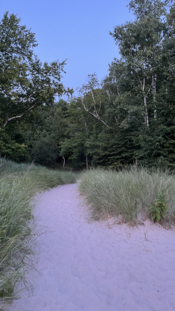TheoLeakas2005
Member
Hey folks!
For whatever reason, I have always been most interested photos that primarily feature blues, pinks, and magentas, and my favorite photos usually combine all three in even lighting. Obviously, blue hour is the time of day to make these pictures, but all of my prior experience has been shooting in either studio lighting, or hard lighting from the sun, and I'm having trouble "predicting" how my colors will look. Effectively, I need help understanding how to "read' the light.
Yesterday I escaped to the beach to try and make some photos. Facing west, I took a picture with my iphone camera to remember how the light looked at that time, and took another picture facing east (both attached). The west photo gave generally a pretty accurate reproduction of what the scene looked like, but in the east photo, the sand became a lovely shade of pink, definitely not how it looked in real life. Why did this happen? Post-processing error? I unfortunately did not take a photo on my SLR to compare.
My understanding has always been that (unless you're shooting velvia or some high saturation pro film like Ektar) that you're hardly ever going to get colors that aren't present to the naked eye. In essence, taking a picture of a softly lit sky at sunset won't magically reveal shades of magenta and pink that aren't 'actually there'. Is this assumption correct?
However, when I look at landscapes at blue hour (particularly the work of Alex Burke, who rarely uses color filters), it's hard to imagine the scene actually looking like that in real life. It makes me wonder what photographic tricks there are to accentuate these colors naturally, and if my phone picture is a step in the right direction to achieving those kinds of scenes.
I guess my question is this:
1: What happened in my phone photo with the sand?
2: Are there colors that will be visible on a long(ish) exposure that won't be visible to the naked eye? If so, how can I "see" these?
3: How can I 'read' the sky (clouds, combination of sun, direct light at sunset vs filtered through clouds, etc.) to promote these colors?
For whatever reason, I have always been most interested photos that primarily feature blues, pinks, and magentas, and my favorite photos usually combine all three in even lighting. Obviously, blue hour is the time of day to make these pictures, but all of my prior experience has been shooting in either studio lighting, or hard lighting from the sun, and I'm having trouble "predicting" how my colors will look. Effectively, I need help understanding how to "read' the light.
Yesterday I escaped to the beach to try and make some photos. Facing west, I took a picture with my iphone camera to remember how the light looked at that time, and took another picture facing east (both attached). The west photo gave generally a pretty accurate reproduction of what the scene looked like, but in the east photo, the sand became a lovely shade of pink, definitely not how it looked in real life. Why did this happen? Post-processing error? I unfortunately did not take a photo on my SLR to compare.
My understanding has always been that (unless you're shooting velvia or some high saturation pro film like Ektar) that you're hardly ever going to get colors that aren't present to the naked eye. In essence, taking a picture of a softly lit sky at sunset won't magically reveal shades of magenta and pink that aren't 'actually there'. Is this assumption correct?
However, when I look at landscapes at blue hour (particularly the work of Alex Burke, who rarely uses color filters), it's hard to imagine the scene actually looking like that in real life. It makes me wonder what photographic tricks there are to accentuate these colors naturally, and if my phone picture is a step in the right direction to achieving those kinds of scenes.
I guess my question is this:
1: What happened in my phone photo with the sand?
2: Are there colors that will be visible on a long(ish) exposure that won't be visible to the naked eye? If so, how can I "see" these?
3: How can I 'read' the sky (clouds, combination of sun, direct light at sunset vs filtered through clouds, etc.) to promote these colors?











